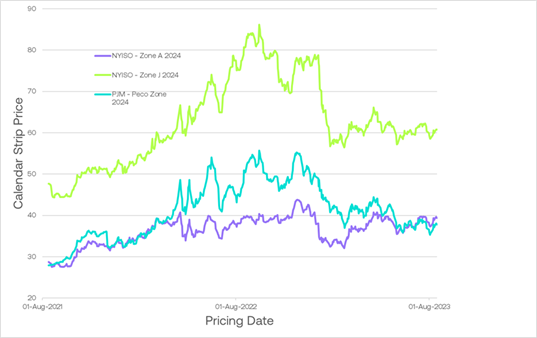Smartest Insight | Issue 131

Our weekly company round-up covers the key market and industry news in one place, so you don’t have to look any further to stay ahead.
August 16, 2023
Market Update:
Temps continue to be hot in Texas and the rest of the country. The northern Atlantic region continues to be spared from extreme temps this summer. This has translated into mild pricing across PJM, NYISO and NEISO. We are sitting right in the middle of hurricane season. NOAA's updated season forecast calls for a 60%, up from 30%, chance of active hurricanes this year. So far there has only been five named storms but expect there to be a total of 16 this season. Record warmer water temps are sited at the main contributor to the update. Where a hurricane makes landfall could impact energy prices in either direction. For example, should a hurricane land near a production site will increase prices. However, if it impacts a city center or LNG facility, we can expect price to come down, in general.
Natural gas storage expectation for the week ending August 12th is expected to be a build of +35 BCF. This is just shy of the 5-yr average of +41 BCF. There is a chance that we may end the storage injection season around 4 TCF, which is right at the top of the 5-yr average range. Currently we are sitting at 3 TCF but is doable given the mild demand we've seen this year. Prompt month NG is tracking in the $2.60's.
In PJM, stakeholders are working to revise capacity market rules. The focus is to enhance reliability and account for the changing fuel mix. Four issues they are attempting to address include: 1) Enhanced risk modeling 2) Evaluation of the Capacity Performance construct 3) Improved accreditation 4) Synchronization between the RPM and Fixed Resource Requirement rules.
As more renewable generation choose to participate in the capacity market, it has introduced more generation with lower capacity factors. At the same time with the expectation of more extreme temps in the winter and summer there is a need to beef up the expectation of reliable resources.

Regulatory Report:
States weigh in on Regional Energy Expansion Project
Eight states with aggressive greenhouse gas reduction policies are opposing the US Federal Energy Regulatory Commission (FERC) regarding the expansion of the Transcontinental Gas Pipe Line. FERC's approval of the Regional Energy Expansion Project, an 829 MMcf/d gas pipeline, has sparked legal disputes due to concerns about environmental protection and energy policy. The expansion would connect northern Pennsylvania production to Northeast demand, mostly serving local distribution companies in New Jersey. Economic studies clashed over the project's necessity, with New Jersey regulators arguing against additional gas capacity, highlighting their state's existing capacity and clean energy goals.
The New Jersey Division of Rate Counsel, aligned with environmental groups, challenged FERC's decision, asserting that FERC misinterpreted New Jersey's clean energy laws and obligations. The issue has now reached the US Court of Appeals for the District of Columbia Circuit. A coalition of eight states, including New Jersey, submitted a friend-of-the-court brief, emphasizing FERC's duty to consider states' sovereign choices to adopt clean energy laws and policies. They argue that FERC disregarded state law, ignored potential impacts on consumer rates and climate laws, and failed to assess the risk of stranding billion-dollar investments.
This legal battle reflects broader state frustrations with FERC's decision-making processes, highlighting clashes over clean water and greenhouse gas considerations. The outcome could influence the interplay between state climate laws and FERC's authority under the Natural Gas Act.
New Jersey Offshore Wind
The New Jersey Board of Public Utilities (NJBPU) has received four offshore wind project proposals for the state's third solicitation, aiming for up to 4 GW of power. Leading Light Wind, led by Invenergy and energyRe, wants to build a 2.4 GW capacity 40 miles off the southern coast near Long Beach Island, promising over $3 billion in economic benefits. Notably distant from shore, this choice could be due to concerns about local protests and environmental impact. German utility RWE and US utility National Grid's joint venture, Community Offshore Wind, plans a 1.3 GW project 37 miles offshore, offering $6 billion in benefits to the state. Shell New Energies US and EDF Renewables North America propose a project 10-20 miles offshore, details pending. A fourth unnamed proposal was also submitted.
Governor Phil Murphy targets 11 GW of offshore wind by 2040. The third solicitation seeks 1.2 GW to 4 GW, following a previous award of 3.75 GW. While interest in New Jersey's offshore wind potential grows, companies express cost concerns linked to supply chain challenges. Orsted, involved in the Ocean Wind I project, gained tax credit rights without crediting subsidies back to ratepayers, sparking Atlantic Shores to seek similar treatment. This legislative move coincided with federal regulators approving Orsted's offshore wind project plan. The NJBPU is expected to take action on the third solicitation in early 2024.
